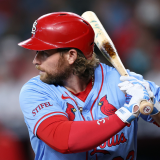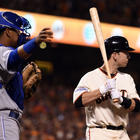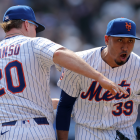Report: Changes to strike zone, intentional walk may be coming in 2017
Soon the strike zone may start at the top of the knee cap and pitchers won't actually have to throw pitches for intentional walks

According to ESPN's Jayson Stark, MLB's competitive committee agreed to drastic changes to the strike zone and intentional walks at the quarterly owners' meetings in New York this week. The changes could go into effect as soon as next season.
In a nutshell, the committee has agreed to raise the bottom of the strike zone slightly and eliminate the need for pitchers to actually throw pitches during an intentional walk.
Here's more from Stark:
The committee agreed on a motion to effectively raise the lower part of the strike zone to the top of the hitter's knees, sources said. The current rules stipulate that the zone begins at "the hollow beneath the kneecap," but the change is a reaction to a trend by umpires to call strikes on an increasing number of pitches below the knees.
The change in the intentional-walk rule would end the traditional practice of requiring the pitcher to lob four balls outside the strike zone. Instead, a team could signify it wants to issue an intentional walk, and the hitter would be immediately sent to first base, sources said.
It's important to note these rule changes are not final. This is only step one of the process. The rules committee has to approve the changes, and while the MLBPA approval is not necessary, it's customary for MLB to present the changes for review. The same is true for the umpires' union.
The rule changes are designed to increase offense and further improve pace of play. Eliminating the need to throw pitches for an unintentional walk will cut down on "dead time," though it also eliminates the opportunity for something weird to happen. A wild pitch, for example. Or Miguel Cabrera hitting an RBI single when the other team is trying to intentionally walk him.
Raising the strike zone will eliminate the low strikes -- Jon Roegele of the Hardball Times has done some great research showing the strike zone has gradually been getting larger and larger in recent years -- and also lead to more balls in play as pitchers have to elevate a bit to get called strikes. More balls in play means more baserunners and generally more excitement.
So far this season batters are striking out in 21.1 percent of their plate appearances -- the highest strikeout rate in history -- and walking 8.4 percent of the time. So nearly 30 percent of all plate appearances are ending in a strikeout or walk, and, frankly, strikeouts and walks are boring. People want action, meaning balls in play.


















